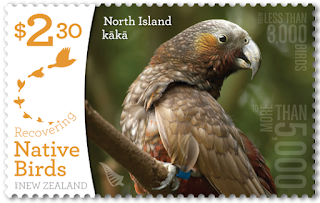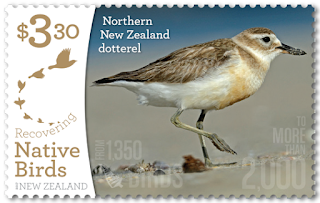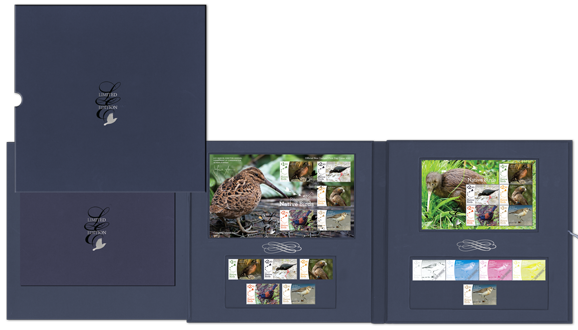
New Zealand’s native birds have a unique history in terms of how and why they adapted into the mostly flightless species we are so well acquainted with today. A predominant lack of mammalian predators in the early days of their evolution meant that many species began to grow larger and lost the ability to fly. With the main predator being other birds, many native species also evolved without the instinct to run from trouble.
This posed a huge problem when the arrival of humans brought with it the arrival of mammalian predators such as rats, cats and stoats, all of which still pose a threat to our native species today.
This stamp issue focuses on five native bird species that have been brought back from the brink of extinction thanks to the hard work of agencies such as the Wildlife Service and the Department of Conservation. Their great work has seen them go on to become world leaders in bird conservation.
The Stamps.
$1.00 - Campbell Island Teal.
This flightless duck was believed to be extinct due to predation by rats and cats on Campbell Island. In 1975, less than 30 birds were discovered on nearby Dent Island. Of these, 11 were caught to establish a captive-breeding programme at Pukaha/Mt Bruce. After years of failure, one of the three females finally bred, and the captive population then flourished. In 2000, 24 captive-bred birds were released on Codfish Island pending the eradication of rats from Campbell Island which was accomplished in 2001. Between 2004 and 2006 150 teal were returned home. The total population is now over 250 birds.
$2.20 - Black Stilt.
A combination of predation by feral cats and other carnivorous mammals, loss of breeding habitat, and cross breeding with pied stilts, reduced the population of pure black stilts to a few dozen birds in the Mackenzie Basin of inland Canterbury. Control of predators and weeds in breeding areas and collection of eggs for artificial incubation at special facilities near Twizel has seen the population rise to about 100 birds, despite occasional setbacks from severe winter weather.
$2.30 - North Island Kaka.
Kaka nest in tree cavities in old forests, and while this provides good protection from the elements, it makes them vulnerable to mammalian predators, especially stoats. In many mainland populations, the sex ratio of this parrot is skewed in favour of males because many females are killed on the nest. Possums and rats compete for fruit but pest control and eradication from islands, and the creation of fenced sanctuaries has seen rapid growth from about 3,000 birds to over 5,000 and has balanced the sex ratio.
$2.70 - South Island Saddleback.
In the 1800s and early 1900s, introduced predators exterminated this ancient wattlebird from the South and Stewart Islands, leaving them living on just three islands off the southwestern corner of Stewart Island. In 1963, ship rats reached these remaining islands and emergency action was taken in 1964 to transfer 36 birds to two nearby rat-free islands. They flourished and have since been shifted to many other islands that were naturally free of rats, or that had been successfully cleared of rats, and now number over 2,000 birds.
$3.30 - Northern New Zealand Dotterel.
This wader breeds mainly on the sandy coasts of the northern North Island. Coastal breeding brings problems such as nests being destroyed by off-road vehicles and accidental disturbance by beachgoers. Predation by cats, stoats, ferrets and other carnivorous mammals is an ongoing serious problem. Protection of favoured breeding sites with temporary fences and pest control has led to strong population increases in eastern Northland, Coromandel and the Bay of Plenty bringing the overall population up from 1,350 in the 1990s to more than 2,000 today.
Special Collector Items.
The 2017 Recovering Native Birds - Stamps First Day Cover.
The 2017 Recovering Native Birds - Miniature Sheet First Day Cover.
The 2017 Recovering Native Birds - Miniature Sheet.
Set of Plate Blocks. Set of Value Blocks.
Set of Full Sheets.
The 2017 Recovering Native Birds - Presentation Pack.
Limited Edition.
The 2017 Recovering Native Birds - Limited Edition Miniature Sheet.
The 2017 Recovering Native Birds - Presentation Pack.
Technical information
Date of issue:
|
2 August 2017
|
|---|---|
Number of stamps:
|
Five gummed stamps
|
Denominations:
|
$1.00, $2.20, $2.30, $2.70 & $3.30
|
Stamps designed by:
|
Jonathan Gray, New Zealand Post
|
Printer and process:
|
Southern Colour Print by offset lithography
|
Number of colours:
|
Four process colours (CMYK) plus high gloss litho varnish
|
Stamp size and format:
|
48mm x 30mm (horizontal)
|
Paper type:
|
Tullis Russell 104 gsm gummed stamp paper
|
Number of stamps per sheet:
|
25
|
Perforation gauge:
|
14.585 x 14
|
Period of sale:
|
Unless stocks are exhausted earlier, these stamps will remain on sale until 1 August 2018. First-day covers will remain on sale until 1 October 2017.
|
Information & images for this post came from.














We appreciate your engagement with our content. To ensure a respectful and constructive community, please take note of the following:
- No Spam, Please: We do not tolerate spammy or promotional comments. Any such comments will be promptly removed.
- Moderation in Place: All comments are moderated to maintain a positive and inclusive environment. Please be patient, as it may take a little time for your comment to appear.
- Sign In with Google: To comment, please sign in using your Google account. This helps us maintain the integrity of our community and allows for better interaction.